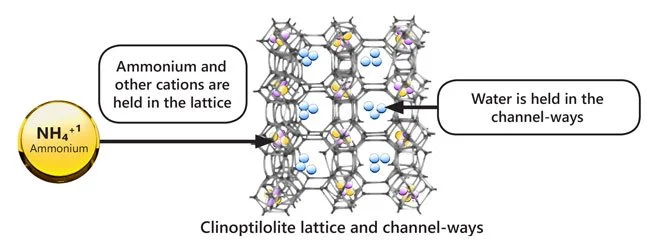CLINOPTILOLITE ZEOLITE
Clinoptilolite lattices are negatively charged and loosely hold cations such as calcium, sodium, ammonium, and potassium. The lattice cavities hold up to 55% by weight in water.
The ability of clinoptilolite to exchange one cation for another is known as "cation-exchange capacity" or "CEC".* Clinoptilolite can release beneficial elements while capturing and binding undesirable elements and compounds.
EXAMPLES:
Beneficial elements: As ruminants intake feed, ammonium is bound in clinoptilolite zeolite, preventing nitrogen overload in the rumen. Later on, sodium from saliva exchanges with the ammonium through CEC to release gradually as the animal chews cud. The result is a gradual release of energy for better feed utilization.
Harmful elements: Research studies have reported that mycotoxins in feed were bound in the clinoptilolite, reducing the detrimental effects to animal health.
CLINOPTILOLITE HAS TWO WAYS OF HOLDING CATIONS AND OTHER ELEMENTS:**
Adsorption: Ammonium and other cations are held in the negatively charged lattice through CEC (cation exchange capacity) and are not water soluble.
Absorption: BRZ™ can hold up to 55% of its weight in water in its channel-ways making it an excellent desiccant. Atoms, molecules or ions are more loosely held in the channel-ways and are water soluble.
*Cation-exchange capacity is a measure of the number of cations per unit weight available for exchange, usually expressed as milliequivalents per 100 grams of material.
** Cations are positive ions, such as ammonium calcium, sodium and potassium.


